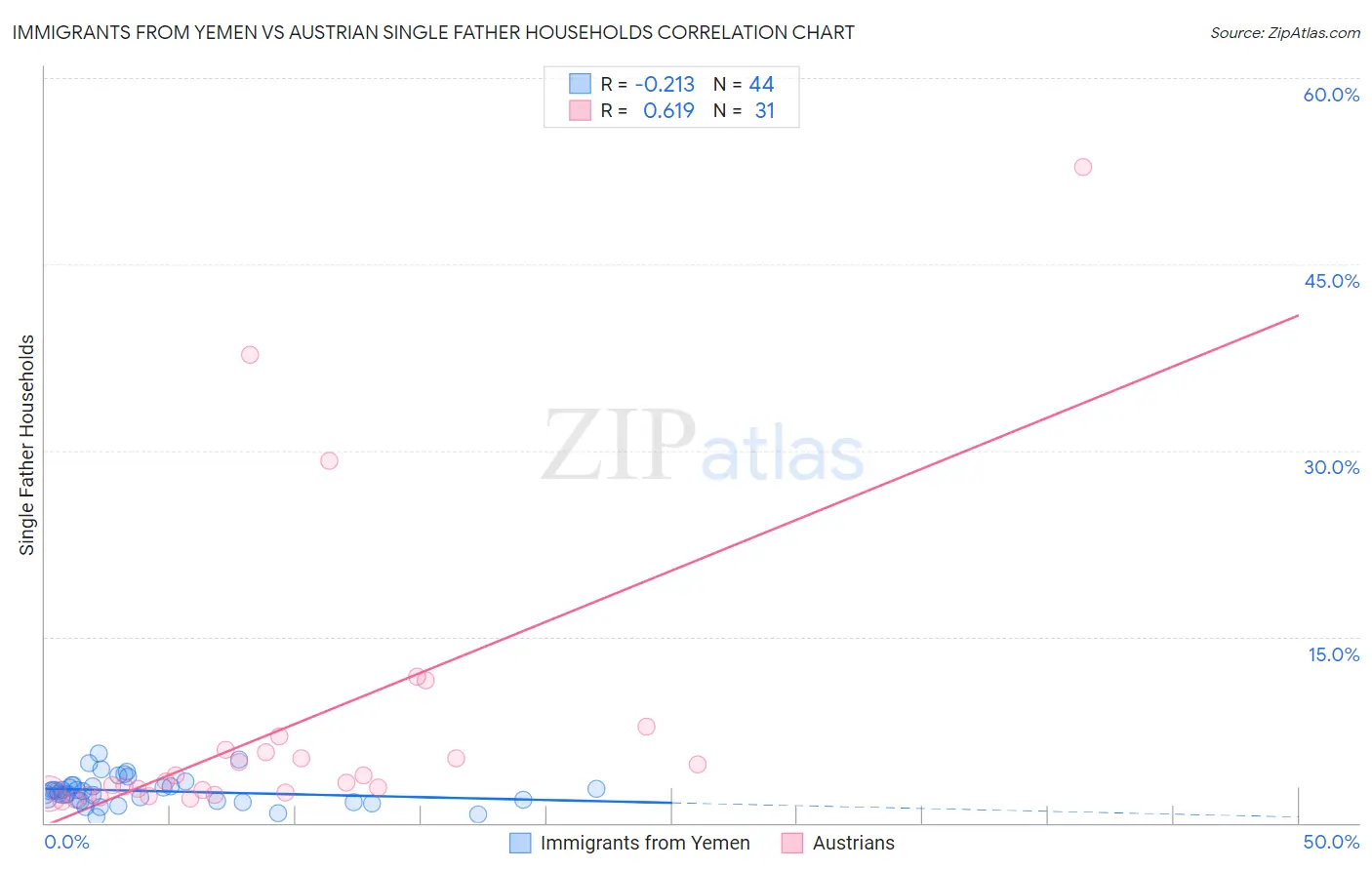Immigrants from Yemen vs Austrian Single Father Households
COMPARE
Immigrants from Yemen
Austrian
Single Father Households
Single Father Households Comparison
Immigrants from Yemen
Austrians
2.2%
SINGLE FATHER HOUSEHOLDS
97.5/ 100
METRIC RATING
123rd/ 347
METRIC RANK
2.2%
SINGLE FATHER HOUSEHOLDS
94.2/ 100
METRIC RATING
137th/ 347
METRIC RANK
Immigrants from Yemen vs Austrian Single Father Households Correlation Chart
The statistical analysis conducted on geographies consisting of 82,364,844 people shows a weak negative correlation between the proportion of Immigrants from Yemen and percentage of single father households in the United States with a correlation coefficient (R) of -0.213 and weighted average of 2.2%. Similarly, the statistical analysis conducted on geographies consisting of 445,997,732 people shows a significant positive correlation between the proportion of Austrians and percentage of single father households in the United States with a correlation coefficient (R) of 0.619 and weighted average of 2.2%, a difference of 1.7%.

Single Father Households Correlation Summary
| Measurement | Immigrants from Yemen | Austrian |
| Minimum | 0.50% | 1.8% |
| Maximum | 5.6% | 52.8% |
| Range | 5.1% | 51.0% |
| Mean | 2.6% | 7.7% |
| Median | 2.5% | 3.4% |
| Interquartile 25% (IQ1) | 1.8% | 2.3% |
| Interquartile 75% (IQ3) | 3.0% | 5.9% |
| Interquartile Range (IQR) | 1.2% | 3.6% |
| Standard Deviation (Sample) | 1.1% | 11.4% |
| Standard Deviation (Population) | 1.1% | 11.3% |
Demographics Similar to Immigrants from Yemen and Austrians by Single Father Households
In terms of single father households, the demographic groups most similar to Immigrants from Yemen are British West Indian (2.2%, a difference of 0.020%), Immigrants from Indonesia (2.2%, a difference of 0.070%), Immigrants from Iraq (2.2%, a difference of 0.15%), Australian (2.2%, a difference of 0.25%), and Immigrants from Brazil (2.2%, a difference of 0.25%). Similarly, the demographic groups most similar to Austrians are West Indian (2.2%, a difference of 0.030%), Chilean (2.2%, a difference of 0.11%), Syrian (2.2%, a difference of 0.23%), Zimbabwean (2.2%, a difference of 0.34%), and Brazilian (2.2%, a difference of 0.45%).
| Demographics | Rating | Rank | Single Father Households |
| Australians | 97.7 /100 | #120 | Exceptional 2.2% |
| Immigrants | Brazil | 97.7 /100 | #121 | Exceptional 2.2% |
| Immigrants | Iraq | 97.6 /100 | #122 | Exceptional 2.2% |
| Immigrants | Yemen | 97.5 /100 | #123 | Exceptional 2.2% |
| British West Indians | 97.4 /100 | #124 | Exceptional 2.2% |
| Immigrants | Indonesia | 97.4 /100 | #125 | Exceptional 2.2% |
| Moroccans | 96.9 /100 | #126 | Exceptional 2.2% |
| Jordanians | 96.9 /100 | #127 | Exceptional 2.2% |
| Immigrants | England | 96.8 /100 | #128 | Exceptional 2.2% |
| Serbians | 96.8 /100 | #129 | Exceptional 2.2% |
| Immigrants | Chile | 96.7 /100 | #130 | Exceptional 2.2% |
| Immigrants | Jordan | 96.6 /100 | #131 | Exceptional 2.2% |
| Poles | 96.5 /100 | #132 | Exceptional 2.2% |
| Taiwanese | 96.3 /100 | #133 | Exceptional 2.2% |
| Zimbabweans | 95.1 /100 | #134 | Exceptional 2.2% |
| Syrians | 94.8 /100 | #135 | Exceptional 2.2% |
| Chileans | 94.5 /100 | #136 | Exceptional 2.2% |
| Austrians | 94.2 /100 | #137 | Exceptional 2.2% |
| West Indians | 94.1 /100 | #138 | Exceptional 2.2% |
| Brazilians | 92.8 /100 | #139 | Exceptional 2.2% |
| British | 92.8 /100 | #140 | Exceptional 2.2% |